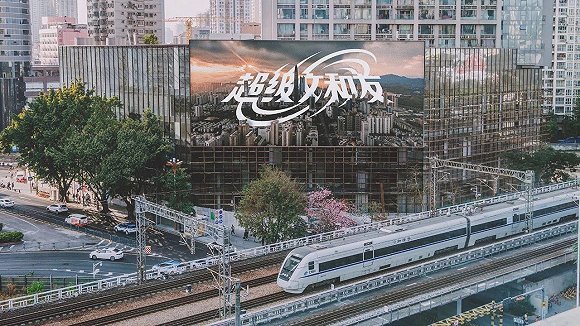As blow-in mass caterer Super Wenheyou harvests the profits of Guanzhou’s love of nostalgia, Jiemian News asks, can the gimmick become the backbone of an international eatery empire?

By WU Rong

Super Wenheyou is no typical city center restaurant. It is more like a night market, with neon lights and food stalls. The whole place is decked out like a street scene from 30 years ago, with the same advertising and staff dressed appropriately.
Guangzhou Super Wenheyou is said to have cost 200 million yuan (US$29 million). During trial operations in the run-up to opening on July 12, there were as many as 2,000 customers a day.
Surrounded by malls and offices, Super Wenheyou has become a popular talking point, with its so-called vintage design and powerful visual statement. Some see it as an eyesore among the resplendent modernity of Guangzhou CBD, while others like it, saying it reminds them of the cyberpunk atmosphere of Kowloon’s Walled City in Hong Kong.

Wenheyou was founded in 2011 when Wen Bin opened his first store in Changsha, capital of Hunan Province. Since then, the Wenheyou family has been blessed with many offspring: Wenheyou Crayfish, Wenheyou Sausage and Wenheyou Stinky Tofu. In 2018, with US$10 million from the Tangrenshen Group, Wenheyou Hisense Plaza opened in Changsha. The glorified food court, home to more than 100 semi-independent traders, changed its name to “Super Wenheyou” at the end of September, just in time for the National Day holiday. Now covering 20,000 square meters, the mall can handle 12,000 hungry customers a day. Technically, Super Wenheyou is not a restaurant but a “catering complex.”

Just like Super Wenheyou in Changsa, the Guangzhou emporium is a three-floor building occupying a prime location at Taikoo Hui.
The ground floor consists of local street food, with other businesses dotted among the hawkers, such as barbers, stationery stores, tattoo parlors, and bars. The design attempts to stir up a kind of nostalgia for a quite recent era which now seems very distant.
In preparation for the assault on Taikoo Hui, Wenheyou spent $1.14 million on a crayfish restaurant on Guanzhou’s Bejing Road, feeding 3,000 locals each day.
“A fifth of our diners in Changsa were already Cantonese. The Cantonese spend four times more on dining as people from Bejing. So Guangdong was an obvious choice for our first location outside Hunan,” said Wenheyou’s co-founder Weng Donghua.
In a nutshell, Super Wenheyou relies on an exotic visual in an oversized space. People come for a kind of lo-tech immersive experience. Founder Wen once said he wanted a brand as slick as Hermes, that could go toe-to-toe with the world's best. Specifically, he wanted high-end stores on the ground floor, making site selection problematic.

In the case of Changsha Hisense Plaza, Wenheyou intended to buy a shop at the best corner of the city’s leading mall. But things did not go according to plan. The management flat-out refused to allow a late-night snackery in such a location.
It was a different, but not very different, story in Guangzhou.
“Embracing Super Wenheyou as we did, has been our greatest challenge,” said Huang Ying, manager of Taikoo Hui Guangzhou.
The biggest problems were the huge amount of space required and the quirky design, but many of the resident businesses, especially other catering companies, were unhappy. Around 20 smaller traders have set up shop already inside Super Wenheyou Guangzhou, who takes 30 percent of their turnover for the privilege.
To some degree, perhaps due to the distinctly local snacks served up, but more likely down to the overall pizzazz of the place, the restaurant has become a kind of tourist attraction.

Cantonese culture is widely entrenched in lifestyle and language, so it doesn’t take too much effort to play the local-nostalgia card. Nevertheless, you would expect an out-of-towner to lag far behind.
Guangzhou people tend to talk about food a lot, before, during, and after eating. Ordering a meal often involves a long discussion with the wait staff. Online, everyone is chattering about Super Wenheyou and there are plenty of negative comments about queuing and the food being no more than just okay.
Following a similar strategy, Wenhyou has plans to take 10 high-end malls by storm in the next five years, with some locations overseas. A new Super Wenheyou will open in Shenzhen this year, a city with absolutely no basis whatsoever for local nostalgia. Covering nearly 30,000 square meters, it will be six times bigger than its Guangzhou cousin.